The escort carrier or escort aircraft carrier, also called a "jeep carrier" or "baby flattop" in the United States Navy (USN) or "Woolworth Carrier" by the Royal Navy, was a small and slow type of aircraft carrier used by the Royal Navy, the United States Navy, the Imperial Japanese Navy and Imperial Japanese Army Air Force in World War II. They were typically half the length and a third the displacement of larger fleet carriers, slower, carried fewer planes, and more-lightly armed and armored. Escort carriers were most often built upon a commercial ship hull, so they were cheaper and could be built quickly. This was their principal advantage as they could be completed in greater numbers as a stop-gap when fleet carriers were scarce. However, the lack of protection made escort carriers particularly vulnerable, and several were sunk with great loss of life. The light carrier was a similar concept to the escort carrier in most respects, but was fast enough to operate alongside fleet carriers.
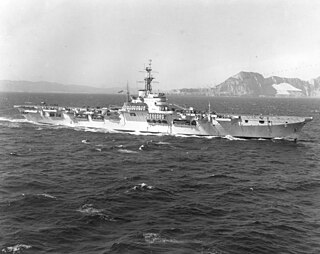
HMS Warrior was a Colossus-class light aircraft carrier which was ordered in 1942 by the British Royal Navy during World War II. Construction was finished in 1945 and upon completion, the aircraft carrier was loaned to the Royal Canadian Navy from 1946 to 1948 as HMCS Warrior. Warrior was returned to the Royal Navy in 1948 and entered service with the British. While in service with the Royal Navy, Warrior was modernised twice, including the installation of an angled flight deck in 1956. In 1948–1949, the ship was used in aircraft landing experiments and fitted with a rubber flight deck and in 1957, was used as the headquarters ship during nuclear testing at Christmas Island. In 1958, the vessel was sold to the Argentine Navy and entered Argentine service in 1959 as ARA Independencia. The aircraft carrier remained in service until 1970 when Independencia was placed in reserve. The following year, the ship was sold for scrap.

USS St. George (CVE-17) was laid down on 31 July 1941 as a C3-S-A2 by Ingalls Shipbuilding, Hull 296 of Pascagoula, Mississippi, under Maritime Commission contract as the (second) SS Mormacland for Moore-McCormack Lines, Inc.,. She was renamed St. George (AVG-17) by the United States Navy on 7 January 1942; and assigned to the United Kingdom under Lend-Lease as HMS Pursuer on 24 February 1942. The vessel was launched on 18 July 1942, sponsored by Mrs. Mary Ann S. Bartman. The escort carrier was reclassified ACV-17 on 20 August 1942, acquired by the US Navy and simultaneously transferred to Britain on 14 June 1943. She was reclassified CVE-17 on 15 July 1943.

USS Pybus (CVE-34) was initially a United States Navy Bogue-class escort carrier. The ship was transferred to the United Kingdom for service in the Royal Navy as the Ruler-class escort carrier HMS Emperor (D98) as part of the Lend-Lease program of World War II. Entering service in 1943, the ship took part in operations against the German battleship Tirpitz and the invasions of Normandy and southern France. Returned to the United States following the war, the carrier was sold for scrap in 1946.
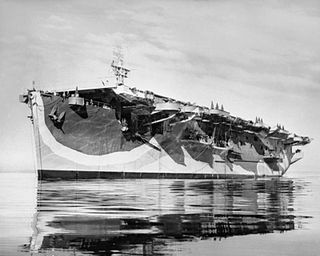
USS Bastian (CVE-37) was a Bogue-class escort aircraft carrier built by Seattle-Tacoma Shipbuilding of Tacoma, Washington, laid down on 25 August 1942 and launched 15 December 1942. She was transferred to the United Kingdom, under Lend-Lease and commissioned on 4 August 1943 as the Ruler-class escort carrier HMS Trumpeter (D09).
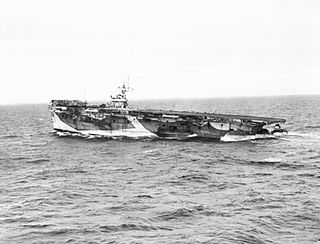
HMS Nabob (D77) was a Ruler-class escort aircraft carrier which served in the Royal Navy during 1943 and 1944. The ship was built in the United States as the Bogue-classUSS Edisto (CVE-41) but did not serve with the United States Navy. In August 1944 the ship was torpedoed by the German submarine U-354 while participating in an attack on the German battleship Tirpitz. Nabob survived the attack, but upon returning to port, was considered too damaged to repair. The escort carrier remained in port for the rest of the war and was returned to the United States following it. Nabob is one of two Royal Navy escort carriers built in the United States which is listed as lost in action during World War II. The ship was sold for scrap by the United States but found a second life when purchased and converted for mercantile use under her British name, Nabob. Later renamed Glory, the ship was sold for scrapping in 1977.
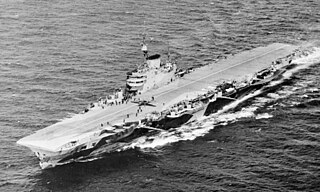
HMS Indefatigable was one of two Implacable-class aircraft carrier built for the Royal Navy (RN) during World War II. Completed in 1944, her aircraft made several attacks that year against the German battleship Tirpitz, inflicting only light damage; they also raided targets in Norway. The ship was transferred to the British Pacific Fleet (BPF) at the end of the year and attacked Japanese-controlled oil refineries in Sumatra in January 1945 before joining the American forces in March as they prepared to invade the island of Okinawa in Operation Iceberg. Indefatigable and the BPF joined the Americans in attacking the Japanese Home Islands in July and August. Following the end of hostilities she visited ports in Australia, New Zealand and South Africa.

The Implacable-class aircraft carrier consisted of two aircraft carriers built for the Royal Navy during World War II. Derived from the design of the Illustrious class, they were faster and carried more aircraft than the older ships. They were initially assigned to the Home Fleet when completed in 1944 and attacked targets in Norway as well as the German battleship Tirpitz. Subsequently, they were assigned to the British Pacific Fleet (BPF).

HMS Implacable was the name ship of her class of two aircraft carriers built for the Royal Navy during World War II. Upon completion in 1944, she was initially assigned to the Home Fleet and attacked targets in Norway for the rest of the year. She was subsequently assigned to the British Pacific Fleet (BPF) where she attacked the Japanese naval base at Truk and targets in the Japanese Home Islands in 1945. The ship was used to repatriate liberated Allied prisoners of war (PoWs) and soldiers after the Japanese surrender, for the rest of the year. Implacable returned home in 1946 and became the Home Fleet's deck-landing training carrier, a role that lasted until 1950. She briefly served as flagship of the Home Fleet in 1950. During this time she participated in many exercises and made a number of port visits in Western Europe. She was placed in reserve in 1950 and converted into a training ship in 1952, and served as flagship of the Home Fleet Training Squadron. The ship was considered for a major modernisation in 1951–1952, but this was rejected as too expensive and time-consuming. Implacable was decommissioned in 1954 and sold for scrap the following year.

The 1942 Design Light Fleet Carrier, commonly referred to as the British Light Fleet Carrier, was a light aircraft carrier design created by the Royal Navy during the Second World War, and used by eight naval forces between 1944 and 2001. They were designed and constructed by civilian shipyards to serve as an intermediate step between the expensive, full-size fleet aircraft carriers and the less expensive but limited-capability escort carriers.

HMS Perseus was a Colossus-class light fleet aircraft carrier built for the Royal Navy during World War II. The ship was initially named HMS Edgar, but she was renamed in 1944 when the Admiralty decided to convert her into an aircraft maintenance carrier. She was completed in 1945, after the end of World War II, and she made a trip to Australia late in the year. Upon her return to the UK in early 1946, Perseus was placed in reserve. The ship was recommissioned in 1950 to serve as the trials ship for the steam catapult then under development. Over 1,600 test launches were conducted before the catapult was removed in 1952 and she was converted for use as a ferry carrier to transport aircraft, troops and equipment overseas. She was reduced to reserve again in 1954 and sold for scrap in 1958.

The USS St. Andrews (CVE-49) was assigned to MC hull 260 on 23 August 1942, a ship to be built to modified C3-S-A1 plans. She was laid down on 12 March 1943 by the Seattle-Tacoma Shipbuilding Corporation of Tacoma, Washington; redesignated CVE-49 on 15 July; and launched on 31 July; sponsored by Mrs. Robert W. Morse; transferred to the United Kingdom under Lend-Lease on 7 December; and commissioned the same day as HMS Queen (D19) in the Royal Navy.

USS St. Simon (CVE-51), an escort aircraft carrier originally classified as an auxiliary aircraft carrier, was laid down on 26 April 1943 at Tacoma, Washington, by the Seattle-Tacoma Shipbuilding Corporation, under a Maritime Commission contract ; reclassified as an escort aircraft carrier, CVE-51, on 15 July 1943; launched on 9 September 1943; sponsored by Mrs. R. H. Lewis, the wife of Major General R. H. Lewis, Commanding General, Northwestern Sector, Fort Lewis, Washington; assigned to the Commercial Iron Works, Portland, Oregon, for the completion of construction; and delivered to the Royal Navy, under lend-lease, on 31 December 1943.

HMS Tracker (BACV-6/D24) was a Attacker-class escort carrier that was built in the United States, but served in the Royal Navy during World War II.

The Bogue class were a class of 45 escort carriers built in the United States for service with the US Navy and the Royal Navy, through the Lend-Lease program, during World War II. Following the war, ten Bogue-class ships were kept in service by the US Navy and were reclassified for helicopter and aircraft transport operations.

HMS Searcher was a Ruler-class escort carrier of the Royal Navy. Built in Seattle as a Bogue-class, she was transferred to the United Kingdom under Lend-Lease. Launched in 1942 she served until 29 November 1945. She was sold into merchant service and renamed Captain Theo. In 1966, she was renamed again to Oriental Banker and was finally scrapped in Taiwan in 1976.

HMCS Algonquin was a V-class destroyer, laid down for the Royal Navy as HMS Valentine (R17) and transferred to the Royal Canadian Navy on completion during the Second World War. She saw service in the Second World War escorting the aircraft carriers that bombed the Tirpitz in March 1944 and providing naval gunfire support to the Normandy landings. The destroyer was to participate in the Pacific Campaign but the war ended before her arrival in that theatre. Algonquin was converted in 1953 to a frigate and spent the majority of her remaining career in the Atlantic, being paid off in 1970.
The Malta-class aircraft carrier was a British large aircraft carrier design of World War II. Four ships were ordered in 1943 for the Royal Navy, but changing tactical concepts, based on American experience in the Pacific War, caused repeated changes to the design, which was not completed before the end of the war. All four ships were cancelled in 1945 before they were laid down.
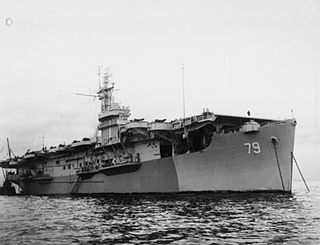
The Ruler class of escort aircraft carriers served with the Royal Navy during the Second World War. All twenty-three ships were built by the Seattle-Tacoma Shipbuilding Corporation in the United States as Bogue-class escort carriers, supplied under Lend-Lease to the United Kingdom. They were the most numerous single class of aircraft carriers in service with the Royal Navy.

The Attacker class were a class of escort aircraft carriers in service with the British Royal Navy during the Second World War.

















